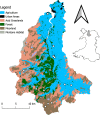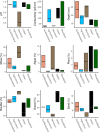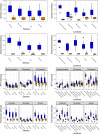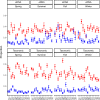Environmental DNA provides higher resolution assessment of riverine biodiversity and ecosystem function via spatio-temporal nestedness and turnover partitioning
- PMID: 33941836
- PMCID: PMC8093236
- DOI: 10.1038/s42003-021-02031-2
Environmental DNA provides higher resolution assessment of riverine biodiversity and ecosystem function via spatio-temporal nestedness and turnover partitioning
Abstract
Rapidly assessing biodiversity is essential for environmental monitoring; however, traditional approaches are limited in the scope needed for most ecological systems. Environmental DNA (eDNA) based assessment offers enhanced scope for assessing biodiversity, while also increasing sampling efficiency and reducing processing time, compared to traditional methods. Here we investigated the effects of landuse and seasonality on headwater community richness and functional diversity, via spatio-temporal dynamics, using both eDNA and traditional sampling. We found that eDNA provided greater resolution in assessing biodiversity dynamics in time and space, compared to traditional sampling. Community richness was seasonally linked, peaking in spring and summer, with temporal turnover having a greater effect on community composition compared to localized nestedness. Overall, our assessment of ecosystem function shows that community formation is driven by regional resource availability, implying regional management requirements should be considered. Our findings show that eDNA based ecological assessment is a powerful, rapid and effective assessment strategy that enables complex spatio-temporal studies of community diversity and ecosystem function, previously infeasible using traditional methods.
Conflict of interest statement
The authors declare no competing interests.
Figures






References
-
- Díaz, S. et al. Summary for policymakers of the global assessment report on biodiversity and ecosystem services of the Intergovernmental Science-Policy Platform on Biodiversity and Ecosystem Services. Nat. Resour. Environ.34, (2020).
-
- Laureto LMO, Cianciaruso MV, Samia DSM. Functional diversity: an overview of its history and applicability. Nat. Conserv. 2015;13:112–116. doi: 10.1016/j.ncon.2015.11.001. - DOI
-
- Gilbey J, et al. Life in a drop: Sampling environmental DNA for marine fishery management and ecosystem monitoring. Mar. Policy. 2021;124:104331. doi: 10.1016/j.marpol.2020.104331. - DOI
-
- de Chazal J, Rounsevell MDA. Land-use and climate change within assessments of biodiversity change: a review. Glob. Environ. Chang. 2009;19:306–315. doi: 10.1016/j.gloenvcha.2008.09.007. - DOI
Publication types
MeSH terms
Substances
Associated data
LinkOut - more resources
Full Text Sources
Other Literature Sources

